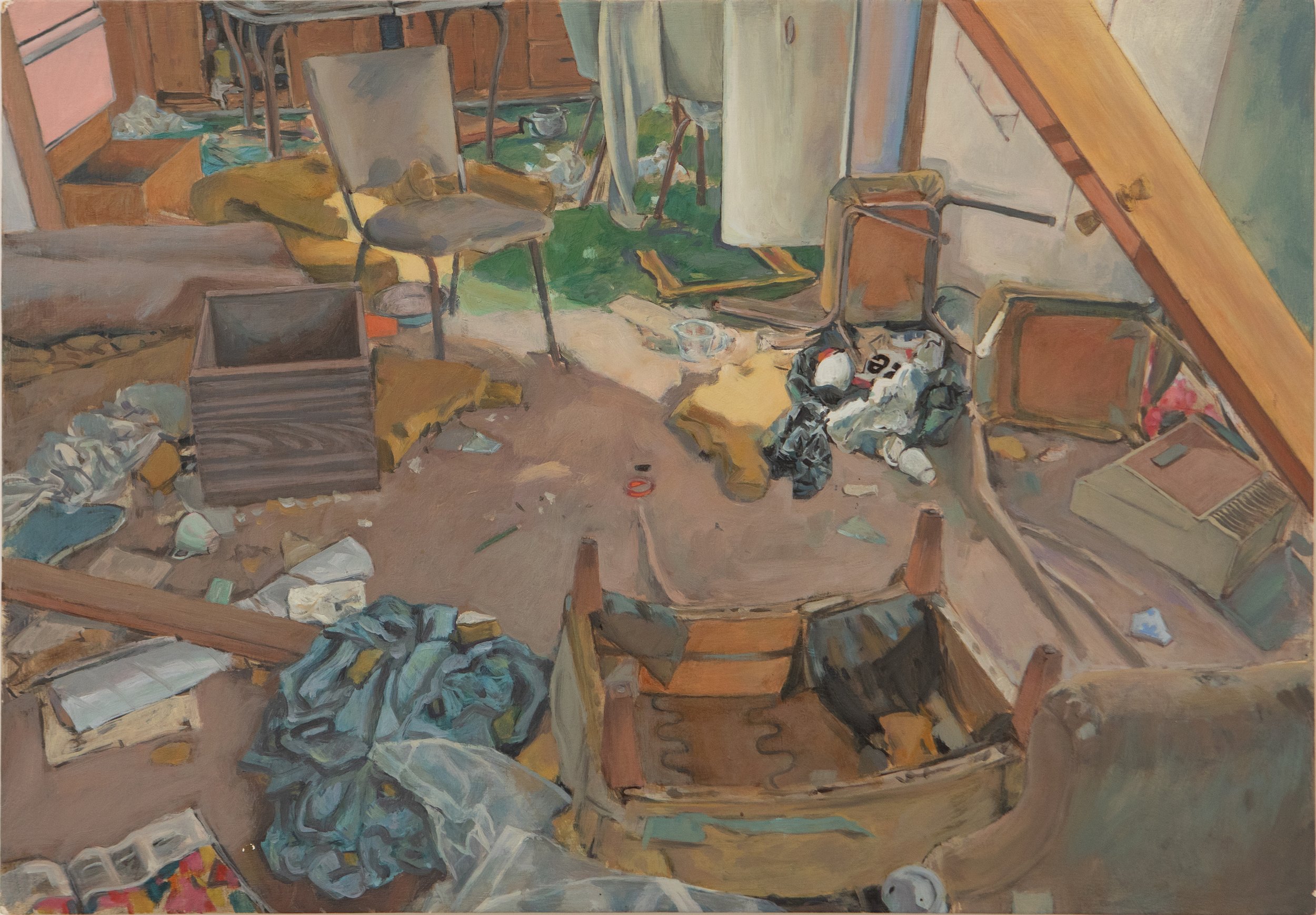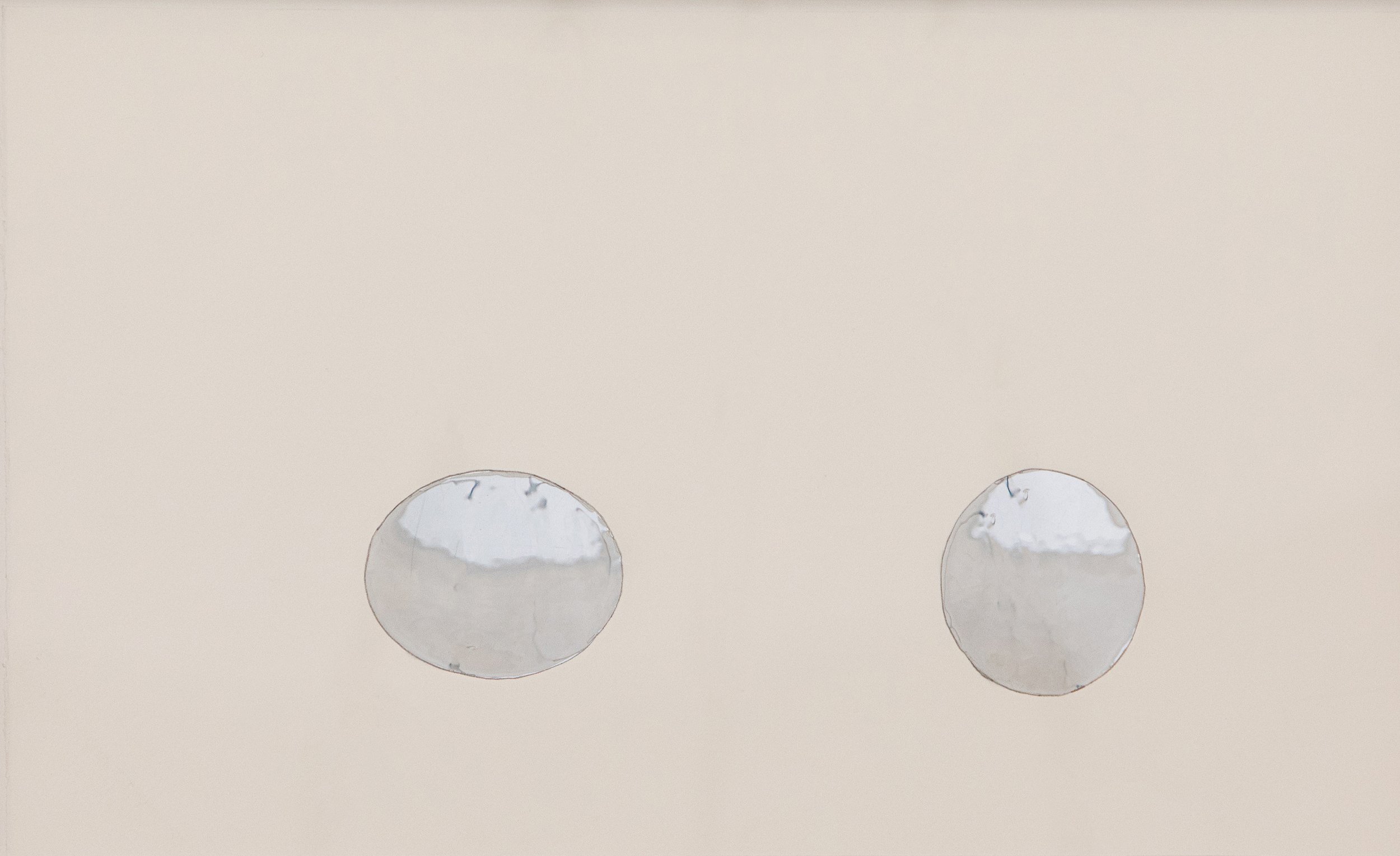
May 2023
The Wilds
Greg Colson | Kristopher Raos | Allen Ruppersberg | Deanna Thompson | Sarah Vanderlip | Ali Vaughan
Deanna Thompson, Vacation Cabin Interior, 2009, oil on panel, 14 x 20 1/8 inches
To commemorate RAM gallery’s inaugural exhibition in Bakersfield, Amanda Quinn Olivar asks the participating artists to share their connection to the city and introduce their work.
In putting together the inaugural exhibition for RAM, the work needed to pay homage to place. The exhibition's title references Eve Babitz's 1978 essay Bakersfield. During a weekend getaway to Kern County, Babitz takes in the culture and toggles between bemusement and bliss as she observes the people, landscape, industry, food, and music. She begins the essay with an invitation:
"What I want to do is, one Saturday, we'll wrap all our troubles in dreams and get in the car (you drive), and I'll take you on my glorious Weekend in THE WILDS of Kern County."
The artists in The Wilds are uniquely bound to Bakersfield by birth, profession, or choice. By highlighting their contributions to contemporary art and connection to Bakersfield, The Wilds' aim is to provoke a reconsideration of the creative legacy of the Central Valley.
Rachel McCullah Wainwright
Owner & Director, RAM Gallery
Greg Colson
FLOW AND VOLUME OF UNION WORKERS, 2019, acrylic, graphite, and paper on wood panel, 47 x 58 inches
I grew up in the Oildale section of Bakersfield, about a block from the oilfields. My brothers and I would ride our bikes out among the drilling rigs. The peculiar stripped-down appearance of things affected my aesthetic sense. Bakersfield was, and is, a region where most of the focus is on "the basics" - agriculture, oil, sports, and Merle Haggard. As an introverted kid with an interest in art, I was fortunate to run into a number of inspiring teachers in Bakersfield, starting with Bill Ryan (at North High School) and later on George Ketterl (at Cal State University Bakersfield) and the exceptional group of visiting artists he brought up from Los Angeles to teach during my three years there.
The striking contrast between Bakersfield's social/physical environment and the philosophical ideas I encountered in art greatly impacted me as a teenager. Both aspects are important in life - and are ingrained in my artworks almost unconsciously.
My paintings in The Wilds exhibition allude to systems of work and rest. FLOW AND VOLUME OF UNION WORKERS is a psychedelic version of a flow chart depicting stages of labor during the construction of a high-rise building. The simplified pillow shapes in ACCENT PILLOWS become abstract forms floating in space. The progression of expanding briefcase symbols in Job Growth is adapted from a graph depicting employment growth in the U.S. In these works, I wanted to present symbols of function and efficiency outside their usual context and see them for all their strangeness.
Kristopher Raos
Kristopher Raos, Untitled (Nobody Home, Blown Away), 2022, acrylic and gouache on canvas, 61 x 80 inches
I am a native of Bakersfield. I remember living in a few areas in Bakersfield, but most vividly, we settled on Cottonwood Road. The significance of the Cottonwood works, particularly, are autobiographical to the neighborhood I grew up in and an homage to that place and time in my life. As far as the “I” can see (backed up on the 10 FWY) wasn’t planned notably for The Wilds; it made sense that moving to Los Angeles and not being a native and looking out into the vastness of the landscape, whether on the freeway and looking down at the endless traffic jam, or feeling stuck in my home on Cottonwood looking far into a more favorable situation was always something I was transfixed on.
Allen Ruppersberg
Poster Object (Progress not Adventure), 1988, silkscreen on canvas, 22 x 14 inches
My current connection to Bakersfield comes from an additional studio/archive/library space I rented some years ago. Previously my partner, Annette Leddy, and I had been coming to Bakersfield from LA to visit her family and explore the city. We both came to enjoy the experience, especially the Padre Hotel, so when I needed extra space for my collections and studio space, I thought, why not get to Bakersfield? Now I have a great space right across the street from the Padre.
As for the work in the show, my concern was to show various works across different mediums. I selected works from the inventory at my gallery in LA, Marc Selwyn Fine Art, and then let Rachel (McCullah Wainwright, owner of RAM gallery) decide what fit in with her ideas for the initial show. My practice does not depend on signature work, and this was the image I wanted to present to a new audience. Each piece begins anew and uses the methods needed to complete the idea. I was never concerned with a specific medium.
Deanna Thompson
Untitled (pink house), 2007, oil on canvas, 12" x 9 inches
Deanna Thompson (1958-2015) began her painting career in Bakersfield before moving to Los Angeles and settling in Yucca Valley in the 1990s. For more than three decades, she was influenced by the vast landscape of the California desert. Primarily living and working in isolation, Thompson explored the modern tension between society and her overwhelming natural environment. Thompson’s paintings describe a sense of beauty found in the marks of human activity passed. Her works reinvent the romantic view of the landscape, painting in favor of one that is unsentimental and rooted firmly in the moment. Through her subject matter of deserted homesteads and discarded manufactured objects, Thompson addressed issues of memory, time, and the forgotten by reframing the material components of modern life to create dense portraits of the world as it surrounds us.
Born in Bakersfield, California, Thompson studied painting at CSU Bakersfield before moving to Los Angeles. She began exhibiting in 2010, and her work is in the permanent collection of the Museum of Contemporary Art, San Diego. On the occasion of her first solo exhibition in 2010, the Los Angeles Times’s Christopher Knight noted her ability to “imbue [a landscape] with quiet mystery [and]...subtle desperation” as well as her ”unostentatious integrity.
Sarah Vanderlip
Untitled (Double Elipses Study #15), 2023, silver mylar and graphite on paper, 18 x 29 inches
My work in The Wilds comes indirectly from teaching sculpture, drawing, and professional practices at CSU Bakersfield for the last two decades. As an artist, for me, living in Los Angeles is imperative and thus has led to countless hours commuting through the expansive beauty of the Grapevine. The drive provided me the calm I needed to solve my art problems, and it was there that I first conceived my Truckhead sculptures- comprised of convex, oval endcaps (ellipses) I saw on the oil tanker trucks I passed regularly. The works in this current exhibition are from a series of large and small-scale studies for Double Ellipses sculptures I created after the Truckhead pieces in 2019 and continue to make.
Ali Vaughan
Bird Over Field, 2020, oil on panel, 24 x 36 inches
I produced most of the pieces included in this show in 2020. That year, I returned to my hometown of Bakersfield after four years in the Bay Area to move in with my family during the pandemic. While there, I began to reassess my direction and relationship with Bakersfield as a place.
When looking at Bakersfield's landscape, I am interested in how human industry relates to the landscape's topology and the people who live here. The works in the show speak to the visual symbols and patterns created by remnants of the agriculture and oil industries. These human interventions on the landscape create a visual rhythm that resonates with my sense of Bakersfield as a place. They also speak to space and how the vast open spaces of the Central Valley are quite literally delineated by the interests and concerns of these industries, whether through the gridding of agricultural fields or the way that power lines recede endlessly into the horizon.
Various pieces contain the image of a bird, which became an avatar from which to consider Bakersfield through an aerial view. The aerial view also implied the distance I had gained after time away from Bakersfield and what felt like a newfound ability to zoom out from where I had grown up and look at it in a new way.
The Wilds (installation view), RAM Gallery, Bakersfield, March 10 — May 26, 2023
The Wilds
RAM
Bakersfield
March 10 — May 26, 2023






